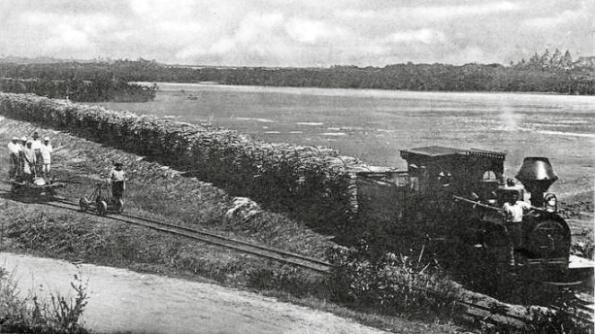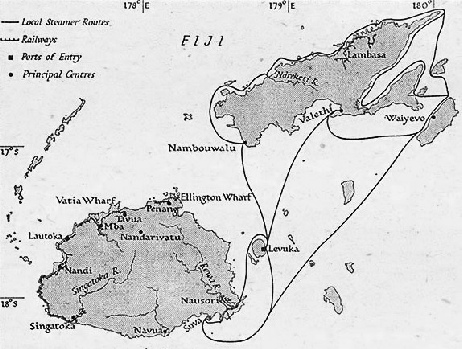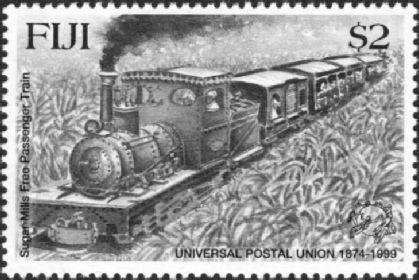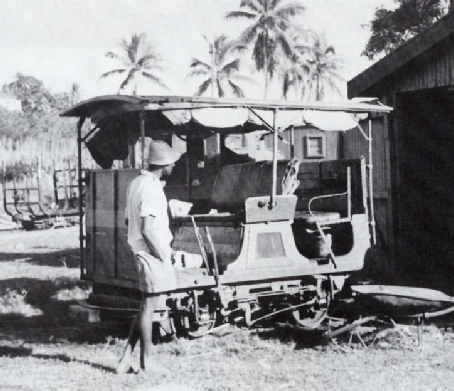The Development of Railways in the South Pacific
RAILWAYS OF THE COMMONWEALTH - 20

TRANSPORTING SUGAR CANE. A Hudswell Clarke 0-6-0 locomotive hauling a train of sugar cane to one of the factories on Fiji.
FIJI is the second largest island complex in the south Pacific area and in terms of mineral wealth and agricultural output one of the most prosperous. It also had the distinction of being colonised by the British. In the middle years of last century British rule meant railways, for the heritage of Trevithick and Stephenson hung heavy on our shoulders. Unlike neighbouring New Zealand, Fiji’s was not a government railway but one, or rather several, built by the Colonial Sugar Refining Company which followed the sailors, the soldiers and the administrators to help open up and develop the country.
The Fijian Island complex is made up of over a hundred islands, most of them small, and it is only the two main ones that need concern us: Viti Levu, the largest of the group, and Vanua Levu to the northeast, the second largest. In both islands the land was suitable for growing sugar cane on the northern and western sides where the mountain ranges stopped most of the rain-bearing easterly winds; the only exception was an attempt to grow sugar near Suva, the capital of Fiji, but it has not been a success. To take the smaller island of Vanua Levu first, most of the population and nearly all the workable land are situated on the north coast on each side of Lambassa, the largest town on the island and indeed the only one worth calling a town. For about 30 miles to the east and five to the west, the coastal plains are suitable for growing sugar cane and along the coastal strip a long meandering railway has been laid to the Colonial Sugar Refining Company’s standard gauge of 2 ft. From this “main” line various branches run a few miles up the fertile flood plains of river valleys into the hills.
The sole function of this network of railways is to haul sugar cane from the plantations into the Colonial Sugar Refining Company’s mill at Lambassa and substances such as fertilisers, much of it the fibres of the cane after the sugar has been extracted, back to the plantations. It appears that until the entire system was worked by three Fowler steam locomotives. One was an 0-6-0 and two were 0-6-2’s of that strange Fijian compromise, the tender/tank engine, in which the water was carried in side tanks and the coal, or rather fuel, in a tender. There was in addition an elderly Hudswell Clarke diesel shunter that pottered about the Lambassa mill and sallied forth to tow in any steam loco that had broken down. Like the rest of the Colonial Sugar Refining Company’s system in Fiji, the lines on Vanua Levu are now mainly diesel worked. The lines serving the Lambassa mill were always isolated and merely a microcosm of those on the main island of Viti Levu, their locomotive design and working practices were the same but on a smaller scale and their purpose exactly the same - hauling cut sugar cane to the mill for refining.
On Viti Levu there are four mills concerned with processing raw sugar cane, the biggest being at Lautoka on the extreme west side of the island. Linked to it by a network of 2 ft gauge railways is a mill at Rarawai near the strangely named town of ‘Mba (pronounced Baa). Some miles to the north-west of this system there are a few miles of railway covering the northernmost corner of Viti Levu feeding into a mill at Penang and linking it with its port at Ellington wharf. Finally, breaking the rule that sugar is best grown on the dry western side of the islands, there is a series of short and disjointed lines in the Rewa River valley, about ten miles from Suva, feeding a mill at Nausori on the Rewa delta. At one time there was another mill tramway at Tamanua to the southwest of Suva, but as it has long since been closed and was not one of the Colonial Sugar Refining Company’s properties it is only mentioned to complete the history of the Fijian railways; although it did boast two or three locomotives at one time, much of the haulage was done by horses. It is said that horses had certain advantages whereby when they broke legs or succumbed to sunstroke they could be eaten; locomotives were too tough!

The railways of Fiji. This map shows the principal lines on the main islands of Viti Levu and Vanua Levu.
The south-east corner of Viti Levu, with an annual rainfall of over 100 inches, is really too wet for the successful growing of sugar cane. It was the climate that has been the inhibiting factor through all Nausori’s history. Although the first of the Colonial Sugar Refining Company’s cane-carrying railways in the island, having been opened in 1882, it never developed in the way the mills did on the west coast. Even its motive power was a selection of “hand-me-downs” - two by Fowler and one by Barclay - that wheezed and creaked their way among the mangrove swamps on the banks of the Rewa river.
The Penang system was an isolated section but a very different one from the Rewa Valley lines. The extreme north point of Viti Levu has the reputation of growing the best quality sugar in the islands. It is typical geologically, with a flat alluvial plain along the coast dominated by high, rugged, volcanic hills behind, two spines of which cut the Penang coastal plain off from the rest of the island. The Colonial Sugar Refining Company’s mill at Penang lies in the middle of the system, and the 7 mile line to the east of the mill not only hauls cut cane to the mill but refined products to the port at Ellington. As with all the Colonial Sugar Refining Company’s lines, there are short spurs up some of the more fertile valleys, but unlike most of the lines the Penang section is heavily graded. At various times the line boasted sundry standard Fiji-type Fowlers and Hudswell Clarkes and one elderly Barclay 0-4-0 tender loco.
One facet of most of the Fiji railways is that they operate extensively for six months of the year during the cane-cutting season from mid-June to mid-January, then run only a skeleton service for the rest of the year. Isolated lines, such as Penang and Lambassa, close down nearly completely during the “off” season. Another feature to be mentioned is the laying of “temporary” tracks during the cane-cutting season; they are simply tapped into the nearest permanent line and laid on the surface of the ground to the fields where the cane is being cut. While completely logical from the Colonial Sugar Refining Company’s point of view, the practice is a hazard to road users, as at times the temporary tracks cross main roads and there is no attempt to bury the rails.
The laying of temporary tracks is universal in Fiji, on all the mill systems. During the cutting season over 150 miles of such temporary tracks are used throughout the two islands. All that is but a curtain raiser to the great main line of the Colonial Sugar Refining Company, known officially as the Rarawai-Kavanangasau Light Railway, laying claim to 290 miles of track. It is all single line of 2 ft gauge and is only nine miles short of the former London & North Western Railway’s main line from London to Carlisle. At the peak of cane cutting this line carries a formidable volume of traffic and offers a free passenger train service on two days a week.
The “main” line from Singatoka to Rarawai Mill at ‘Mba, with all its twists and turns included, is probably 120 miles long, but there are many permanent branches and, at each end of the line, secondary lines, such as those from Singatoka to Kavanangasau in the south and from ‘Mba to Tavua in the north. It is a splendid line, opened in stages. It started with the ‘Mba Valley lines in 1885 and those serving the Lautoka mill in 1903; two years later the two systems were connected, and the final extension up the Singatoka valley in the south was brought into operation about 1914. For all its sinuous length, it tends to follow the coastal plain and so, while curves are frequent, gradients and engineering works are slight, apart from bridges over the great river valleys.
Sugar cane tends to grow best on the flat and that is what dictates the main characteristic of Fijian railways. The most sustained gradient on the main line is immediately west of Singatoka where a spine of basalt runs down to the sea; the railway has to get up and over the spine, turning and twisting as it does so and crossing and re-crossing the King’s Road, which forms the main road around the south coast of Viti Levu. This section causes many issues for drivers of motor cars as the Colonial Sugar Refining Company’s trains tend to cut across this road, with locomotives appearing apparently out of nowhere during the peak cutting season.

One of the Colonial Sugar Refining Company’s free passenger trains as depicted on a Fijian $2 postage stamp issued in 1999.
All round the coast the sugar cane traffic is heavy, as every little creek and the flat land about it grows cane. From the railway operating point of view the two mills have their separate spheres of influence. Anything south of Lautoka, including the rich Nandi basin and the Singatoka valley with its tentacles to Kavanangasau, feed the Lautoka mill; whilst everything to the north goes to the Rarawai mill at ‘Mba. The port for export for export of processed sugar is at Lautoka and so between there and Rarawai at the height of the season there has arisen what are called “express goods”, or bulk loads of refined sugar products coming from Rarawai to Lautoka for shipment. During the cane cutting months there can be two or three such workings in the day and they run very hard indeed; even the passenger train has to get out of their way, but as that does not earn hard cash it does not matter. The Rarawai-Lautoka goods must rank among the fastest and hardest duties ever run on the 2 ft gauge.
The free trains are not run out of the goodness of the Colonial Sugar Refining Company’s heart but as part of the contract from the Colonial government granting the company rights to lay the rails. It ran from Lautoka to ‘Mba and back two days a week (Mondays and Thursdays). On Tuesdays and Fridays it wandered down to Singatoka, returning the following day. The usual consist was three coaches of typical Anglo-lndian style with covered tops and open sides, plus a couple of vans and anything else hung on to it “on company service”. Its lasting glory was its locomotive, a Hudswell Clarke 4-4-0 built specially for these trains. The free train still runs, but hauled by a mundane Clyde (Australia) diesel locomotive.
One feature of the Rarawai-Singatoka section is that there is a reasonable amount of traffic throughout the year, unlike the other lines which operate only in the cane-cutting season. During the “off” period traffic is diesel worked, but between June and January steam engines sally forth to haul cane. Most of the newer steam locomotives are equipped with electric headlights and some even with radio-telephones, both essential at the height of the cane season, when the railway works twenty-four hours a day, seven days a week.
Civil engineering features on any of the Colonial Sugar Refining Company lines in Fiji are few - some minor cuttings and embankments and no tunnels. There are many bridges across the rivers flowing from the mountainous central massif to the coast, but they are simple functional things of wooden or steel trestles, often accommodating a road as well as the railway. The locomotive pattern is also equally simple, for with very few exceptions the Colonial Sugar Refining Company standardised on two makers, Fowler and Hudswell Clarke, with Fowler first in the field and holding the ring from 1887 when the first engine came to Fiji until about 1914, and Hudswell Clarke thereafter. Other makers had some input to the Colonial Sugar Refining Company, notably Barclay.

DREWRY RAILCAR used on the Fijian railways.
The Rewa Valley lines were always the home of lost causes, both mechanically and agriculturally. There were quite elaborately equipped sheds at both Rarawai and Lautoka mills, with major repairs and overhauls undertaken at the latter place. The Fowler locos were all originally built as tank engines of either 0-6-0 or 0-6-2 wheel arrangement and then for extra fuel capacity had tenders on neat four-wheeled bogies added. The later Hudswell Clarke engines were built as tender 0-6-0’s from the outset and very neat little engines they were. The “express” engine, 4-4-0 No. 18, was alone in her glory. All the engines, other than No. 18 and one or two small yard shunters, were fitted with the balloon-stack spark-arresting type of chimney which was such a prominent feature of the Colonial Sugar Refining Company locos in Fiji. At one time No. 18 also had a balloon chimney but it was soon removed. Spark-arresting chimneys were essential on machines working in cane fields during the dry season, particularly when burning the mixture of small coal and mill waste that was the Colonial Sugar Refining Company engines’ fuel.
You can read more on “Engineering in New Zealand”, “Island Railways” and “Rail Transport in Ceylon” on this website.






